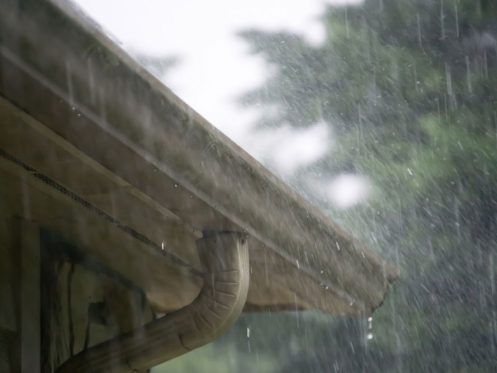A lot of houses have gutters, but it can be hard to tell what role they play in maintaining your home’s exterior. You might even be wondering if gutters are really necessary. Your gutter system is there to direct water away from your home, which helps to prevent mold, mildew, dangerous water buildup, and other types of water damage from developing. While there are a few exceptions, gutters are necessary for keeping your home’s exterior and foundation from getting damaged because it moves rainwater away from your home before it has time to settle.
How Gutters Work
Gutters are installed under the edge of your roof so it can catch rainwater as it runs down its surface. They then direct water to the edge of your roof and into vertical sectionals (called “downspouts”), which will often release the water into drainage systems or extensions that move it away from your home’s foundation. There are even eco-friendly gutter systems that will direct the water into tanks, which can be used for gardening during dry seasons.
When Gutters are Needed
While gutters aren’t required by law, they are needed for most homes because it can prevent damage from occurring. Some of the situations where gutters are needed include but may not be limited to:
- Overhang — If your roof’s overhang is close to your home’s siding, trenches will form around your foundation whenever it rains. These trenches can cause severe and costly damage that could have been prevented by installing a gutter system.
- Clay-Rich Soil — Soil that’s rich in clay will absorb and retain water when it gets wet, which can act as a proverbial pipeline that will direct water toward your home’s foundation (often in a single spot). Installing a gutter system will avoid this problem, because it will move water into a drainage system.
Be sure to speak to a professional for more information.
Common Gutter Problems
Gutters can prevent a lot of problems, but they can run into issues that may hinder their performance. Because gutters have large openings, leaves and other forms of debris (such as twigs, pine needles, shingle grit, and pollen) can build up over time. Birds and other animals can also build nests inside your gutters. All of these problems can cause your gutters to clog, which could lead to water damage. You can avoid this problem by doing regular maintenance and cleaning. You can also invest in a gutter guard system.
How You Can Improve Your Gutters
You can improve your gutters by either adding additional structures or by installing a new system that’s made from higher-quality materials. Some of the extra features you can add include the following:
- French drains.
- Rain chains.
- Underground water storage tanks.
- Gutter guard systems.
- Irrigation hookups.
- Rain collection systems.
- Splash blocks.
If you want to improve your gutter system by upgrading the quality of its materials, you will need to remove your old gutters and install new ones. The cost of installing this new system will depend on the materials you choose and the amount of linear feet you need for the entire system. Vinyl and aluminum are the most common choices, which can cost between $1,700 and $2,400 for materials and labor. Higher-end materials (such as steel and copper) can cost from $2,800 to $9,400.
How to Maintain Your Gutter System
It can be hard to maintain your gutters. It can also be dirty and even dangerous, but you should clean them at least twice a year (at the end of both spring and fall). You should also do some type of general upkeep at least once a year. Gutter maintenance will require the use of a number of tools. Some of them include the following:
- Gloves.
- A ladder.
- A gutter scoop.
- An electric drill.
- A stabilizer.
You need to be both experienced and comfortable with working on ladders or roofs. But if you’re not sure, you should hire a professional.
When Gutters are Not Needed
While gutters are often encouraged, there are some situations where they’re not necessary. Some of them include but may not be limited to:
- Concrete — If your home is surrounded by sidewalks, driveways, patios, streets, and other concrete structures, it’s already being protected from rainwater.
- Downward Slopes — If your home sits on top of a hill, it will already do the work of a gutter system with natural water runoff. Just make sure your landscaping has a lot of downward slopes that point away from your home.
- Large Overhang — If your roof has an overhang that’s between six and ten inches, you may not need a gutter system if your home meets other criteria (such as having downward slopes).
- Weather Patterns — If your home is in a drier climate that doesn’t get a lot of rain, you’re not as likely to need a gutter system.
If you’re looking for one of the best places for a gutter installation in Corpus Christi, be sure to reach out to Bayfront Roofing.
